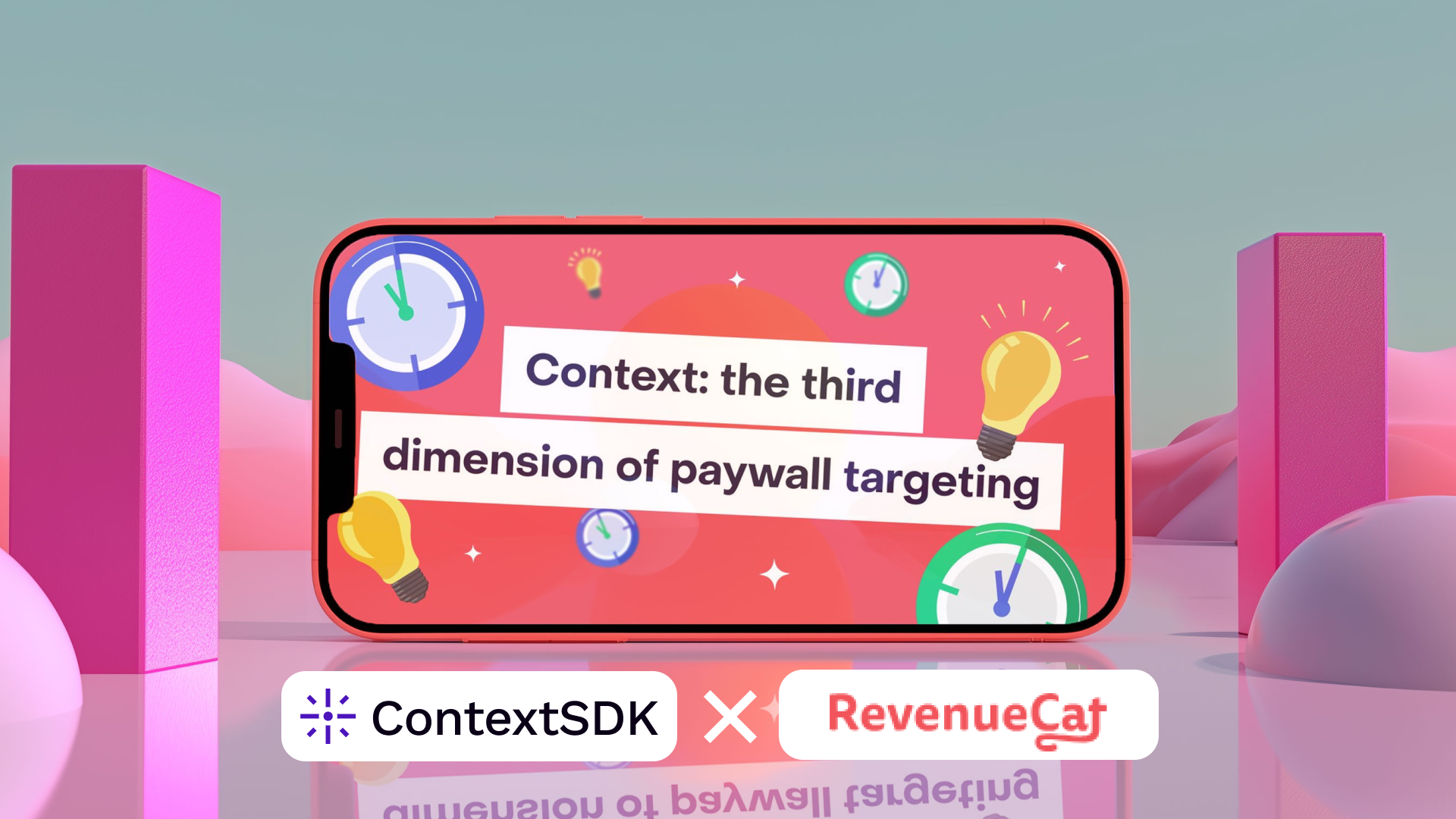Why Context Matters in Pricing Experiments


Introduction
Have you ever wondered if offering a discount at just the right moment could turn a hesitant user into a paying customer? We certainly have. In fact, our team has been experimenting with a full-price vs. discount strategy using our ContextDecision approach – essentially, showing users a special introductory discount only when the context suggests they would otherwise decline the offer. The idea is simple: if the user hits a “bad moment” (e.g. signs of hesitation or intent to leave without subscribing), we trigger an upsell with a discounted price. Bad moment means upsell! By contrast, if the user seems ready to buy or in a “good” moment, we keep the price at full value.
This week, we came across a highly relevant case study on the RevenueCat blog (authored by David Vargas) that validates our theory. The article – “Introductory offers: a key lever for growth” – details how steep introductory discounts drove a huge spike in conversions for a subscription app. The results were eye-opening: an 85% discounted intro price helped boost the install-to-pay conversion rate from around 3% to 14% (a 433% lift) while slashing the cost per acquisition (CPA) from $105 to $13. In other words, many users who wouldn’t have paid full price decided to subscribe when presented with a compelling discounted offer. This dramatic conversion upswing even pushed the app’s monthly recurring revenue (MRR) above $50k for the first time.
So, how does this tie back to our experiment? In this post, we’ll break down the RevenueCat findings and explain how they validate our ContextDecision approach. We’ll also discuss how we plan to balance the positive impact on conversions with the potential downsides (like lower per-user revenue) – all in an accessible way without too much jargon. Let’s dive in.
RevenueCat’s Case Study: Introductory Offers Supercharge Conversion
The RevenueCat case study provides a real-world example of how powerful an introductory discount can be. In the reported experiment, the team radically changed their subscription pricing structure to entice new users. Instead of the usual free trial or full-price paywall, they introduced steep limited-time discounts on their subscription plans:
- Weekly subscription – 85% off the first week’s price (a massive discount to draw users in).
- Monthly subscription – 75% off the first month’s price.
- Yearly subscription – 0% off (no true discount). In fact, they cleverly increased the displayed annual price by 66% and then “discounted” it back to the original price. This psychological trick made it look like the yearly plan was on sale, without actually lowering its normal price – preserving its full revenue value.
All these offers were presented on a paywall with the original prices greyed out and the new discounted prices prominently shown. They even showed the equivalent price per day for each plan to emphasize the affordability of the offers. The logic here was strategic: from previous tests they knew that weekly subscribers tended to have the highest long-term value (since weekly plans renew more frequently). Therefore, they made the weekly plan’s discount deepest (85% off) to maximize sign-ups on that high-value tier.
The outcome? It was nothing short of dramatic. As soon as the introductory offers went live (around early June), the conversion rate from install to paying subscriber skyrocketed. The RevenueCat article reports a 433% increase in conversion rate at the peak, compared to their baseline with no discounts. In practical terms, they went from roughly a 3% conversion rate (typical of their free-trial setup) to about 14% of new users converting to paid subscribers with the discounts.
Figure: Conversion rate of new users to paying subscribers. In the RevenueCat case study, introducing steep introductory discounts in early June caused the install-to-pay conversion to surge from a ~3% baseline to roughly 14% at peak – a 433% lift. This huge uptick in paid conversion demonstrates how many more users can be convinced to subscribe when shown a compelling discounted offer.
This surge in conversions had a ripple effect on customer acquisition costs (CAC/CPA). With so many more users subscribing, the cost to acquire each paying customer plummeted. Previously, their campaigns were yielding a prohibitively high CPA – about $105 per subscriber in an earlier period. After the discounts, the CPA fell to roughly $13 per subscriber. That’s an 86% drop in CPA, fundamentally changing the unit economics of their marketing. With a much lower cost per paying user, the same advertising budget brought in many more subscribers than before. The team noted this was a “completely different story” for their business – for the first time, they saw their MRR (monthly recurring revenue) shoot past $50k, a level they had never reached in previous experiments. In short, the introductory-offer strategy was like unlocking a growth cheat code: way more subscribers at a fraction of the cost, leading to rapid revenue growth.
It’s worth mentioning that timing played a role in their success. As the RevenueCat article explains, this app had just launched a major new feature that was trending on social media (TikTok) and no competitors had it at the time. They promoted this unique feature heavily in TikTok ads, which created a surge of interest and traffic. The introductory discounts then harnessed that wave of interest and converted it efficiently. In other words, the timing and context were ideal for this experiment. The author explicitly concludes: “Are introductory offers worth it? Yes, if the context is right.” - and we like what we are hearing here. Even though he is not 100% relating to real-world context in that regard.
The Trade-Off: Conversion vs. LTV (Lifetime Value)
Intro discounts can feel like a steal—for users and your acquisition metrics. In the RevenueCat test, slashing first-period prices (-80 % to -85 %) catapulted pay-per-install conversion from ~3 % to 14 % and smashed CPA from $105 to $13. Naturally, 30-day LTV fell from $55 to about $10—an 81 % drop that mirrors the discount size.
Seeing the gap, the team quickly trimmed the discount on weekly/monthly plans to steer more people toward the unchanged annual price. Conversions dipped only slightly to 12 %, CPA ticked up to $17 (still an 84 % savings vs. baseline), and early-stage LTV bounced to $14 in just seven days. With payback now projected in <60 days, they hit a sweet spot: huge user growth, rapid ROI, and an upsell path that can lift long-term value.
Key takeaway: use irresistible offers to grab volume, then fine-tune pricing to ensure LTV catches up—fast.
Our Experiment: ContextDecision for Smart Discount Upsells
Reading through the RevenueCat case study, we couldn’t help but feel encouraged. It’s as if someone ran a giant version of the experiment we’ve been planning – and proved that the core concept works. However, our approach, which we call ContextDecision, adds another layer of finesse: we apply discounts selectively, based on user context, rather than to all users by default. Here’s an overview of our experiment strategy:
- Full Price vs. Discount Logic: Users initially see our standard full price subscription offer. We only want to discount if it’s truly needed. If the user is eager to subscribe at full price, fantastic – no discount necessary. But if the user shows signs that they’re not going to convert (for example, they attempt to close the paywall, skip the purchase, or exhibit “exit intent”), that’s when ContextDecision kicks in. We identify this “bad moment” when the user is likely to drop off, and immediately present an upsell with a special discounted offer. The hypothesis is that this contextual discount will catch the user’s interest exactly at the point they would have said “no” and turn it into a “yes.”
- Personalized Introductory Offer: The discounted price we show might be a limited-time introductory rate (for example, a percentage off the first month or first year, similar in spirit to the RevenueCat case). The key difference is we’re not giving away the discount to everyone – only to those who need an extra nudge. In essence, it’s like having a safety net for conversions: we try full price first, and only if the user isn’t biting do we deploy the “special offer.” This way, we protect our revenue from users who are willing to pay full price (they never see a discount they didn’t need), while still capturing users who would otherwise be lost. It’s a form of targeted introductory offer.
- Experiment Design: To validate this approach, we’re running controlled tests. For a random portion of our users (or sessions), ContextDecision will be active – meaning the dynamic upsell could trigger based on the user’s behavior. We’ll compare metrics from these sessions to those where we don’t offer a discount at all (i.e. always full price, even if the user is leaving). This A/B test structure will let us measure the lift in conversion attributable to the contextual discount. We expect to see a conversion increase analogous to what the RevenueCat study saw, though likely on a smaller scale since we’re not blanketing all users with a low price, only the hesitant ones.
- Metrics to Watch: Just as in the RevenueCat case, we’re closely watching the conversion rate (how many more people subscribe with the contextual discount) and the CPA or cost per acquisition (since getting more payers from the same traffic will lower our effective CPA). On the flip side, we’ll monitor LTV over various time frames (7-day, 30-day, etc.) to see how the revenue per user holds up when some users are paying less initially. Our goal is to find a balance where the additional subscribers and lower CPA justify the reduced upfront revenue from the discount. We’ll be calculating what percentage of the acquisition cost is recovered in the first week or month, similar to how RevenueCat’s team looked at LTV-D7 covering 82% of spend. This will tell us if our payback period on ad spend is still in a healthy range.
In summary, our ContextDecision experiment is all about showing the right offer to the right user at the right time. The RevenueCat success story gives us confidence that a well-timed discount can dramatically boost conversions. Now we want to push the concept further by making it smarter – only deploying that discount when context clues suggest a user isn’t convinced by the regular price.
Conclusion: A Promising Path Forward
To wrap up, the RevenueCat case study has given us a much-needed dose of optimism (and some concrete benchmarks) for our own pricing experiment. It showed that introductory discounts can be a powerful lever for growth, capable of boosting conversions by hundreds of percent and drastically lowering acquisition costs. It also taught us about the careful balance required – discounts will cut into short-term revenue, so you have to monitor customer value and adjust to find a profitable equilibrium. Most importantly, it affirmed that contextual decision-making is crucial: the tactic works best under the right circumstances, and part of our job is to create those circumstances intelligently with ContextDecision.
Our theory that showing a discount only to users who need it (“smart” introductory offers) could lift conversions now feels more solid than ever. We’re essentially applying in a nuanced way what the RevenueCat experiment proved at scale: if you give users a reason to say “yes” – be it a time-limited deal or a price that matches their willingness to pay – a lot more of them will say yes. And if you do this in a targeted fashion, you stand to gain subscribers and revenue without leaving too much money on the table.
We’re excited to continue with our Full Price/Discount experiment and will keep a close eye on the results. As the case study’s author emphasized, every experiment is a learning opportunity. We’ll learn, iterate, and share our findings in a future update. Who knows – maybe our next blog post will be celebrating a conversion lift and CPA drop as remarkable as 433% and –86% respectively!






